Related Research Articles
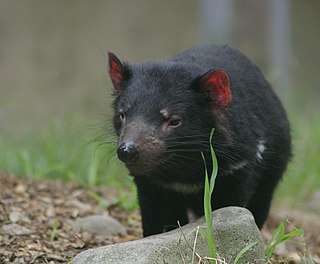
The Dasyuridae are a family of marsupials native to Australia and New Guinea, including 71 extant species divided into 17 genera. Many are small and mouse-like or shrew-like, giving some of them the name marsupial mice or marsupial shrews, but the group also includes the cat-sized quolls, as well as the Tasmanian devil. They are found in a wide range of habitats, including grassland, underground, forests, and mountains, and some species are arboreal or semiaquatic. The Dasyuridae are often called the 'marsupial carnivores', as most members of the family are insectivores.
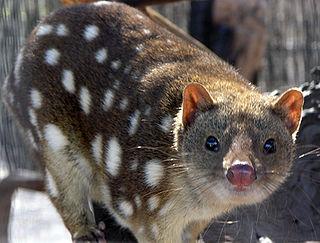
The subfamily Dasyurinae includes several genera of small carnivorous marsupials native to Australia: quolls, kowari, mulgara, kaluta, dibblers, phascogales, pseudantechinuses, and the Tasmanian devil. The subfamily is defined largely on biochemical criteria.

Mulgaras are the six small rat-sized species in the genus Dasycercus. They are marsupial carnivores, closely related to the Tasmanian devil and the quolls, that live in deserts and spinifex grasslands of arid Australia. They are nocturnal, but occasionally "sunbathe" in the entrance of the burrow in which they dwell. Their kidneys are highly developed to excrete extremely concentrated urine to preserve water, as the animals rarely drink. They feed mostly on insects, but also eat reptiles and small mammals. They are seasonal breeders and breed from June to September. The pouch comprises two lateral folds of skin.

The dibbler is an endangered species of marsupial. It is an inhabitant of the southwest mainland of Western Australia and some offshore islands. It is a member of the order Dasyuromorphia, and the only member of the genus Parantechinus. The dibbler is a small, nocturnal carnivore with speckled fur that is white around the eyes.
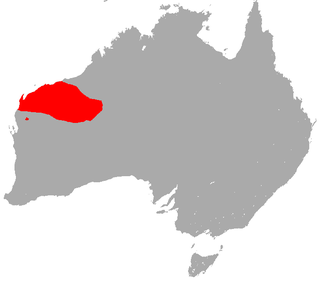
The little red kaluta is a small, reddish-brown, shrew-like mammal native to dry grasslands of northwest Western Australia. It is active at night, feeding on insects and other small animals. The kaluta is a marsupial and is the only member of its genus, Dasykaluta. Individuals are around 10 cm (3.9 in) long and weigh from 20 to 40 g. They live for about four years in captivity. Other common names include little red antechinus, russet antechinus and spinifex antechinus.

Antechinus is a genus of small dasyurid marsupial endemic to Australia. They resemble mice with the bristly fur of shrews.

The tribe Dasyurini includes several genera of small carnivorous marsupials native to Australia: quolls, kowari, mulgara, kaluta, dibblers, neophascogales, pseudantechinuses, and the Tasmanian devil.

The fat-tailed false antechinus, also called the fat-tailed pseudantechinus and red-eared antechinus, is a member of the order Dasyuromorphia. It is an inhabitant of western and central Australia. Its species name, macdonnellensis, refers to the MacDonnell Ranges near Alice Springs, where it was first discovered.
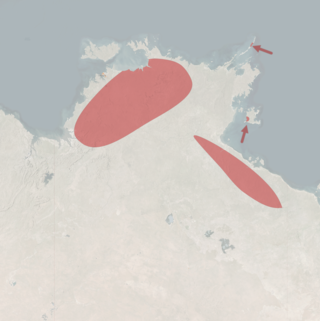
The sandstone false antechinus, also known as the sandstone pseudantechinus, the sandstone antechinus, the sandstone dibbler, Harney's antechinus and the Northern dibbler, is a species of small carnivorous marsupial, which has a patchy distribution in Australia's Northern Territory.
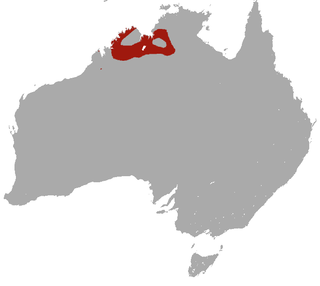
The Ningbing false antechinus, also known as the Ningbing pseudantechinus, is a small species of carnivorous marsupial found in north-western Australia. It is locally common throughout the Kimberley region of Western Australia and the Northern Territory.

Woolley's false antechinus, also known as Woolley's pseudantechinus, is a species of small carnivorous marsupial belonging to the family Dasyuridae. It is found in the Australian state of Western Australia, primarily in the Pilbara, Ashburton and Murchison regions.

Rory Cooper's false antechinus, also known as the tan false antechinus and the tan pseudantechinus, is a recently named species of small carnivorous marsupial which inhabits rocky outcrops in Western Australia. Nothing is known of its behaviour but it is expected that this will be similar to other members of the false antechinus genus. A study published in 2017 found no support for separation as a new species of Pseudantechinus, and the name was proposed to be synonymous with the previously described Pseudantechinus macdonnellensis.

The crest-tailed mulgara is a small to medium-sized Australian carnivorous marsupial and a member of the family Dasyuridae which includes quolls, dunnarts, numbats, the endangered Tasmanian devil and the extinct thylacine. The crest-tailed mulgara is among a group of native predatory mammals or mesopredators endemic to arid Australia.

The brush-tailed mulgara, previously the mulgara Dasycercus cristicauda, is a medium sized carnivorous Australian marsupial species weighing approximately 100 g (3.5 oz). The brush-tailed mulgara is sexually dimorphic with males being much larger than females. Their body length is 12 to 17 cm, and tail length is 6–10 cm (2.4–3.9 in). They store fat in their tail which at times can be over 16 mm (0.63 in) wide at the base.
Jocelyn Mary Taylor was an American mammalogist, who served as president of the American Society of Mammalogists from 1982 to 1984. She was also an honorary trustee of the Cleveland Museum of Natural History. As a pioneer for women in the field of mammalogy, Taylor actively worked to broaden the study, doing so as a member of the American Society of Mammalogists, as a university professor, and through conducting her research, publishing numerous works.
The southern mulgara is a newly described, potentially extinct, species of mulgara. The species is named after Australian palaeontologist Michael Archer, who contributed to many Australian palaeontological and mammalian discoveries.
The northern mulgara is a newly described, and potentially extinct, species of mulgara. The species is named after Dr. Patricia Woolley who previously worked on the genus Dasycercus, and has worked extensively with Australian dasyurids.
References
- 1 2 3 "Dr Patricia Woolley, zoologist". Australian Academy of Science. Retrieved 10 October 2017.
- ↑ Braithwaite, Richard W.; Lee, Anthony K. "A Mammalian Example of Semelparity" (PDF). University of Chicago Press Journals. The American Society of Naturalists. Retrieved 10 October 2017.
- ↑ Woolley, P. A. (1982). "Phallic morphology of the Australian species of Antechinus (Dasyuridae, Marsupialia): a new taxonomic tool?". Carnivorous Marsupials. 2: 767–781.
- ↑ Kitchener, D. J.; Caputi, N. (1988). "A new species of false antechinus (Marsupialia~ Dasyuridae) from Western Australia, with remarks on the generic classification within the Parantechini" (PDF). Records of the Western Australian Museum. 14 (1): 46. Retrieved 10 October 2017.
- ↑ Newman-Martin, Jake; Travouillon, Kenny J.; Warburton, Natalie; Barham, Milo; Blyth, Alison J. (2 October 2023). "Taxonomic review of the genus Dasycercus (Dasyuromorphia: Dasyuridae) using modern and subfossil material; and the description of three new species". Alcheringa: An Australasian Journal of Palaeontology. 47 (4): 624–661. doi: 10.1080/03115518.2023.2262083 . ISSN 0311-5518.
- ↑ "SWG: Past Outstanding Achievement Award Recipients". www.iswg.org.
- ↑ "Elected Honorary Members | American Society of Mammalogists". www.mammalsociety.org.
- ↑ "Honorary Life Membership | The Australian Mammal Society". australianmammals.org.au.